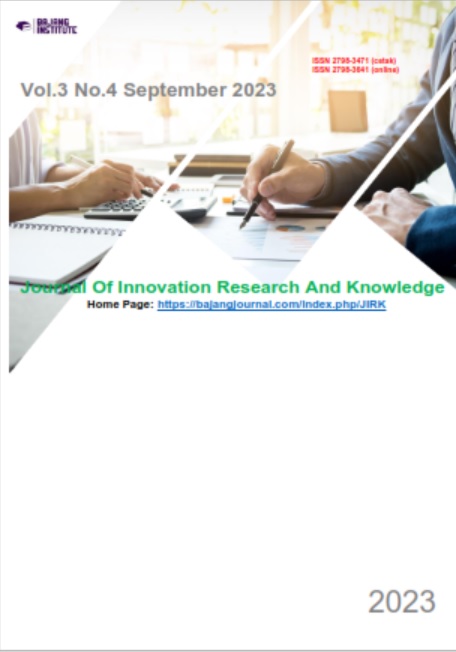UJI AKTIVITAS ANTIOKSIDAN PADA EKSTRAK ETANOL 70% TANAMAN TERATAI PUTIH (Nymphaea nouchali L)
DOI:
https://doi.org/10.53625/jirk.v3i4.6551Keywords:
Antioxidant, DPPH, Nymphaea Nouchali, Quercetin, White LotusAbstract
Many aquatic plants grow in these rivers, one of which is the lotus. Lotus (Nymphaea) is a plant that often lives in the swamplands of South Kalimantan, especially Banjarmasin. The lotus is a wild plant in its natural habitat, which is not foreign to Indonesian people. Some Indonesian people only know about the beauty of this plant. It turns out that apart from its beauty, the lotus also has benefits for curing various diseases. The lotus plant can also be used as medicine because it contains several different chemical ingredients in each part. This research aims to determine the antioxidant activity of extracts from various parts of the White Lotus plant (Nymphaea nouchali L) using the DPPH method. The plant parts tested include: flower parts, flower stalks, leaves and petioles. Based on the research results, the highest antioxidant activity test was found in flower extract, namely with an IC50 value of 66.906 μg/mL, and the lowest was found in leaf extract, namely with an IC50 value of 99.449 μg/mL. Quercetin as a comparison standard has an IC50 value of 6.337 μg/mL with a "very strong" antioxidant activity category, while flower extract, flower stalk extract, leaf extract and leaf stalk extract have a "strong" antioxidant activity category.
References
Kemenkes RI, 2013, Riset Kesehatan Dasar; RISKESDAS, Balitbang Kemenkes RI, Jakarta.
Ismuhajaroh, B.N., Gt. Sugian Noor, G.S., & Erhaka, M.E. 2016. Perbandingan Morfologi Dan Biologi Bunga Pada Dua Spesies Teratai (Nymphaea) Di Kabupaten Banjar, Kalimantan Selatan. Prosiding Seminar Nasional Lahan Basah Tahun 2016 Jilid 3: Potensi, Peluang, Dan Tantangan Pengelolaan Lingkungan Lahan Basah Secara Berkelanjutan. 896-900.
Dalimartha, S. 2006. Atlas Tumbuhan Obat Indonesia. (Jilid 4). Jakarta: Puspa Swara.
Chandra, B., Asra, R. & Mevia, N. A. 2022. Perbedaan Ekstraksi Daun Teratai (Nymphaea Pubescens Willd) Sebagai Fungsi Aktivitas Antioksidan. Higea 14, 28 (2022).
Budiwati, G.A.N. & Kriswiyanti, E. 2014. Manfaat Tanaman Teratai (Nymphaea sp., Nymphaeaceae) Di Desa Adat Sumampan, Kecamatan Sukawati, Kabupaten Gianyar, Bali. Jurnal Simbiosis II. (1): 122- 134.
Sabban, A., Rumahlatu, D., Watuguly, T. 2017. Potensi Ekstrak Daun Teratai (Nymphaea pubescens L.) Dalam Menghambat Staphylococcus aureus. Biopendix, 3 (2), 129-141.
Ellya, H. & Mulyawan, R. 2019. Perbandingan Nymphaea nouchali dan Nymphaea pubescens Berdasarkan Morfologi Daun. Prosiding Seminar Nasional PERHORTI 2019, Banjarbaru 21 – 22 Agustus 2019. 346-349.
Zamzani, I. & Triadisti, N. 2021. Limpasu Pericarpium: an Alternative Source of Antioxidant From Borneo with Sequential Maceration Method. J. prof. medika 15, (2021).
Haerani, A., Chaerunisa, A. Y. & Subarnas, A. 2018. Artikel Tinjauan: Antioksidan Untuk Kulit. Farmaka, 16(2), 135-151.
Ibroham, M. H., Jamilatun, S. & Kumalasari, I. D. A. 2022. Review: Potensi Tumbuhan-Tumbuhan Di Indonesia Sebagai Antioksidan Alami. Seminar Nasional Penelitian 2022 Universitas Muhammadiyah Jakarta, 26 Oktober 2022
Parwata, M.O.A. 2016. Bahan Ajar: Antioksidan. Kimia Terapan Program Pascasarjana Universitas Udayana. April 2016. 39-40.
Prakash, A. 2001, “Antioxidant Activity“ edallion Laboratories : Analithycal Progress, 19 (2) : 1 – 4.
Syamsul, E. S., Anugerah, O., Supriningrum, R., 2020, Penetapan Rendemen Ekstrak Daun Jambu Mawar
(Syzygium jambos L. Alston) Berdasarkan Variasi Konsentrasi Etanol dengan Metode Maserasi, Jurnal Riset Kefarmasian Indonesia, 2(3).
Wijaya, D., Yanti, P. P., A, R. S., Rizal, M. & A, R. S. 2015. Screening Fitokimia dan Aktivitas Antioksidan Daun Eceng Gondok (Eichhornia crassipes). JKV 65–69 (2015) doi:10.15408/jkv.v0i0.4965.
Putri, D. M. & Lubis, S. S. 2020. Skrining Fitokimia Ekstrak Etil Asetat Daun Kalayu (Erioglossum rubiginosum (Roxb.) Blum). AMINA, 2(3).
Triadisti, N. & Zamzani, I. 2023. Column Chromatography Fractionation and Antioxidant Activity of Passiflora foetida Leaves. Borneo J Pharm 6, 22–30 (2023).
Syam, L.K., Farikha J., Fitriana, & Dian N. 2009. Pemanfaatan Limbah Pod Kakao Untuk Menghasilkan Etanol Sebagai Sumber Energi Terbarukan. 2009. Tersedia di: http://repository.ipb.ac.id/handle/1234567 89/20208 [Diakses pada tanggal 22 Mei 2023].
Badaring, D. R., Sari, S. P. M., Nurhabiba, S., Wulan, W. & Lembang, S. A. R. 2020. Uji Ekstrak Daun Maja (Aegle marmelos L.) terhadap Pertumbuhan Bakteri Escherichia coli dan Staphylococcus aureus. Indonesian Journal of Fundamental Sciences. 6, 16.
Prasetyo, E., Kiromah, N. Z. W. & Rahayu, T. P. 2021. Uji Aktivitas Antioksidan Menggunakan Metode DPPH (2,2-difenil-1-pikrilhidrazil) Terhadap Ekstrak Etanol Kulit Buah Durian (Durio zibethinnus L.) dari Desa Alasmalang Kabupaten Banyumas. JPS 8, 75.
Yamaguchi T, Takamura H, Matoba T, Terao J. 1998. HPLC method for evaluation of the free radical-scavenging activity of foods by using 1,1,-diphenyl-2-picrylhydrazyl. Biosci. Biotechnol. Biochem. 62: 1201-1204.
Molyneux, P. 2004. The use of the stable free radical diphenylpicryl- hydrazyl (DPPH) for estimating antioxidant activity. Songklanakarin J. Sci. Technol., 26(2) : 211-219













